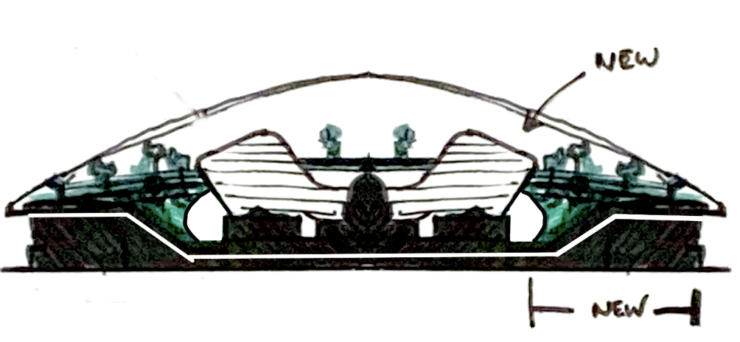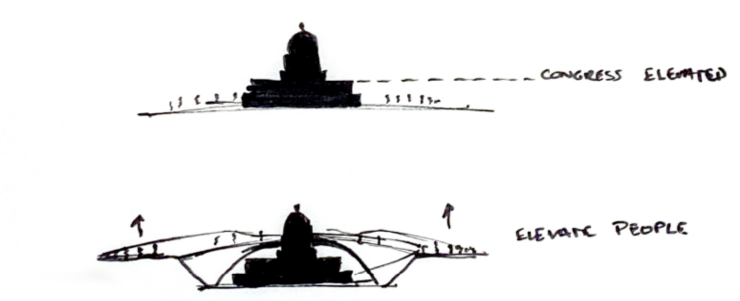Thesis – Week 4 – Review Proposal and Site/Program Development
Paths of access for the public – diagram overlays of the plan from last weeks presentation to think through each floor.
There are other ways for the public to engage with representatives. There are “conference” areas where conversation can happen. There are areas adjacent to their offices they can host visitors and open “protest areas” Next steps will be thinking through how the public moves through the building for a variety of purposes.

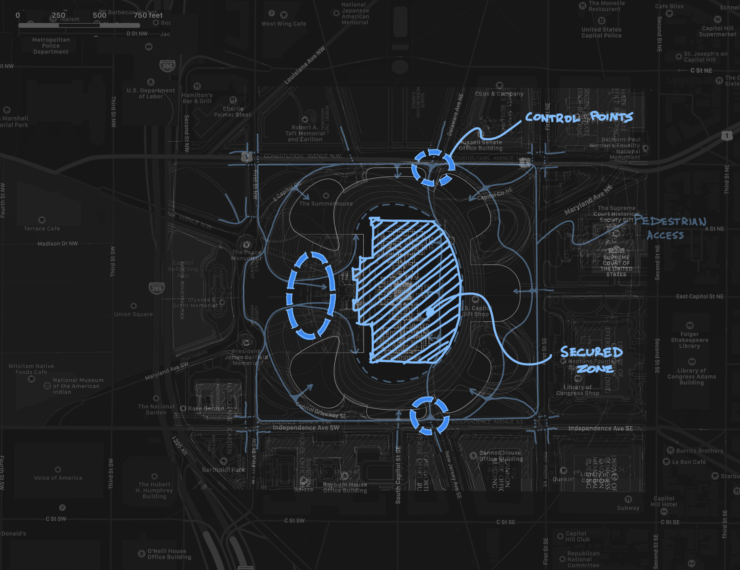
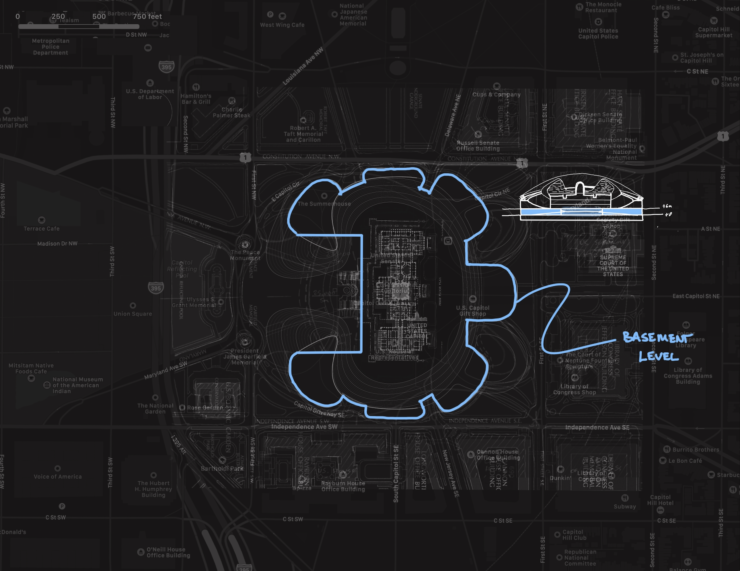
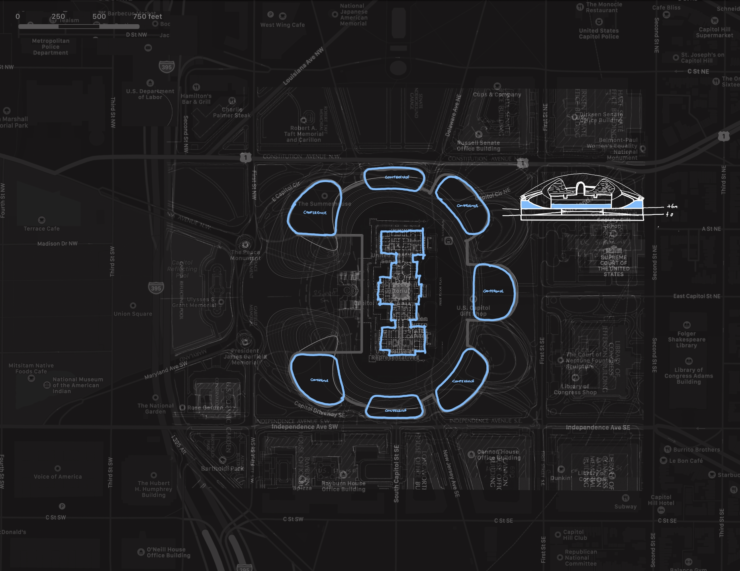
Thesis – Week 3 – Intensive
Effective governance in a representational republic is contingent on a proper proportionate of representation to the population as it grows and evolves to create a more perfect union.
The U.S. Capitol building needs to be increased in size and scope to accommodate proper representation per population.
My thesis will explore a modified design that will increase in size to accommodate a greater representation. The building will need to address global competition of iconic building forms, balancing historic preservation. The subset of the building will need to balance openness with security and create spaces for collaboration and conversation.
Comments and Feedback provided During Presentation
Question from Karen Nelson: Why have representational democracy… what about direct democracy through voting directly?!
Representational democracy has shown to be the best in promoting ideas highlighted by the enlightenment. I support this approach, and history supports representational democracies. I would note that direct democracy is mob rule. We know that a large portion of the population is easily swayed and even to the point not in their long-term interest. I am a supporter of the government as a means to protect the private property of its citizens.
Comment from Karen Nelson: China has many more representatives… but not a representational democracy
The problem with their representatives is that they are not voted but placed. The more fundamental point is that they are representatives of their dictator rather than representing their constituents.
Comment from Susan Morgan: how does your approach acknowledge expectations for civic architecture, for western and US assumptions of classical architecture establishing our validity as a “young” democracy…?
I touched on this a bit when referring to Thomas Jeffersons Academical Village in the use of Roman Architecture as a means to establish a sense of grounding the new republic in one of the greatest republics that ever existed on Earth.
Comment from Susan Morgan: be mindful of the use of terms: “preservation” has specific meaning and expectations, in distinction from rehabilitation, conservation, etc. https://www.nps.gov/tps/standards/four-treatments.htm
Yeah, this is important. Carl even mentioned this… I want to find a way to talk about it as being a problem and holding us back. Carl’s comment about preservation rules would make my proposal impossible, which is precisely the problem.
Comment from Karen Nelson: What do you value about the political processes of the US? What needs revision? What needs keeping? Restoring?
The immediate need is that we have taken away the diversified strategy of governance that was more local. It is common to focus on federal laws, and the media perpetuates this idea. Rather than allowing citizens within California, Massachusetts, or Florida to make their laws and decisions to govern themselves, we focus too wholly on the federal level. To battle this, we need to make it more combative, with more debate. We cannot have critical laws contingent on how one individual will vote and whether or not we can sway that person. That is the sign of the times when we look at one Senator and say, ” How will he vote, and it will impact all citizens. The goal would be to scale up representation (of the people and not representatives of dictators). The legislators would only pass laws that are genuinely bi-partisan and have obvious benefits to the people. If the legislators cannot agree, that means that it should not be legislated at the federal level and that the States need to take a more significant role in passing laws that would be needed to protect and promote the citizens of that State. That is the overall thinking. I need to find a way to manifest them in the overall Thesis. Right or Wrong, that is the stance that I am taking on the proposal, and I want to try to explore that further. If anything, the Thesis will cause discussion around a serious problem that we have, and I am just trying to put out into the world what I think the solution is.
Comment from Susan Morgan: Famous failed dome approach from a master of domes: https://www.historyandheadlines.com/east-st-louis-and-the-old-man-river-project/
This is some good information. Thank you for sharing.
Comment from Paul H: Is your greening of the capitol expansion symbolic of Anti-Federalist (Agrarian) versus Federalist (and Federal-Style architecture)?
I go back and forth on these two, and they exist specifically because there are different thoughts on them. I took the approach of breaking it down and its use depending on whether or not it will support the political position. For instance, the use of Agrarian, nature-oriented, would be utilized when discussions need to occur. Within the final vote, the arena of politics, the place where it becomes challenging to remove that law within that same legislative branch once it is in law. Those spaces should reflect an architecture that is bigger than man and more formal.
Comment from Susan Morgan: worth understanding the difference and similarities in intent and expression of Foster’s Reichstag versus his later London City Hall: https://www.fosterandpartners.com/projects/city-hall/ and http://parliamentbook.com/
Thank you. I will research this more fully.
Comment from Karen Nelson: What is the polemical argument? Heading towards fascism? Here already?
Firstly, just so we are on the same page, I rarely use the word “polemic,” I want to make sure I understand you. I understand a polemical argument as the following: A statement used in opposition or controversy of a proposition.
I don’t, or at least I am not trying to have a polemical argument, but just a pure argument. I am trying to use the facts and precedent written in our federalist papers discussing the proper proportion of representation to its citizens. The reference of this can be found in Federalist No. 58, Federalist No. 55, and there are lighter mentions of the need for it but it is just a broad statement. There is also mention of this same argument in the Federal Constitutional Convention of 1787. I could add this documentation within the Thesis as some supporting precedent.
I do not intend to make any commentary on fascism and whether it is here. The primary goal is to state that we have an issue of under representation, and that I am advocate in the foundation of this country and would like to grow representation as it has worked so well in the past.
Comment from Karen Nelson: https://www.kent.edu/magazine/shed maybe time to bury it and begin anew ontop…
I took the approach of tearing it down vs. “preserving” it depending on the hierarchy of importance. For example, the perimeter buildings that are accommodated for dialogue can be open and not as formal. Still, as legislation becomes more solidified and makes its way to the federal arena, the Architecture should formalize with that same level of importance. The area space is intended to be an architecture that is bigger than man and more formal.
Comment from Karen Nelson: What about the grounds around the capitol
The grounds around will be maintained as much as possible for occupiable green space. Any lost space will be replaced by an elevated green walk that surrounds the federal arena.
Comment from Susan Morgan: Thom: worth reviewing design thoughts about this: https://www.smithsonianmag.com/travel/winners-announced-for-national-mall-design-competition-63914108/
These are friendly spaces within the National Mall, and it reminds me of other programmed spaces like the botanical garden. When master planning, I call this type of stuff the “litter” to activate space. I feel free to use that kind of language here because the entire competition was based around the bias of “dead spaces.” I wonder if a landscape architect intentionally designed an open space for a particular reason, and others call it “dead space.” I am sure. However, I am an advocate for activating spaces like this with skating rinks, fountains, etc.
Comment from Karen Nelson: Are we under-represented? Really>
Yes, we are under-represented; a school board is much more accessible than a house of representatives and even more so than a senator. Scarcity value is a good analogy for this.
Comment from Susan Morgan: Thom and also: https://www.architectmagazine.com/design/memorials-for-the-future-finalists-revealed_o
I need to get on your newsletter! You have a ton of great resources. There is a moment within the building, the house, and the senate chambers that would be converted into a museum space, and I was struggling with what to do with it that wasn’t just locking it in time but making it a more interactive learning experience, and this competition has some great thinking along that line already. Thank you for sharing.
Comment from Karen Nelson: How many people can function?
I alluded to this in my previous response, but the question I am trying to solve has a different importance threshold. When we talk about functioning, yes, it will function. If the key performance metrics are evaluated by whether bills get passed, I am trying to fix that evaluation. We need a new standard for the key performance metrics. The standard should become something similar to “did the bills that get passed have a positive benefit to the people and did a majority agree?” Too often, we pass bills by the margin of a single person, and this is a recent legislative change that we call the “nuclear option.” We can easily say, well, that is the solution to get rid of the nuclear option. That is a solution and should happen, but we also need to address a growing population and wealth to representation that is not growing. It is an obvious problem, and my proposal is to have more representation to fend off the influence of potential corruption.
Read more
